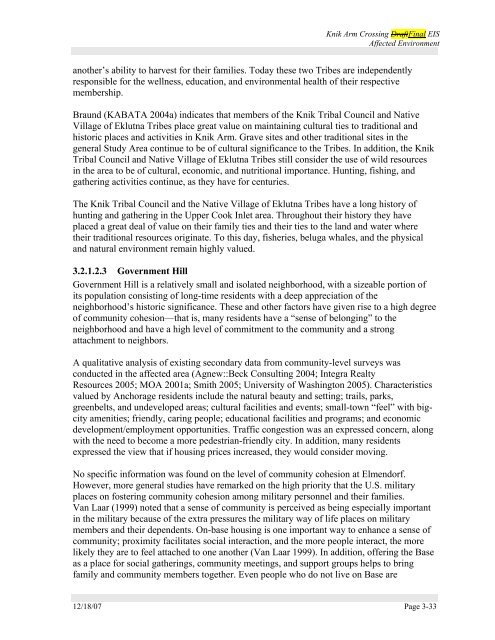3.0 Affected Environment - Knik Arm Bridge and Toll Authority
3.0 Affected Environment - Knik Arm Bridge and Toll Authority
3.0 Affected Environment - Knik Arm Bridge and Toll Authority
Create successful ePaper yourself
Turn your PDF publications into a flip-book with our unique Google optimized e-Paper software.
<strong>Knik</strong> <strong>Arm</strong> Crossing DraftFinal EIS<br />
<strong>Affected</strong> <strong>Environment</strong><br />
another’s ability to harvest for their families. Today these two Tribes are independently<br />
responsible for the wellness, education, <strong>and</strong> environmental health of their respective<br />
membership.<br />
Braund (KABATA 2004a) indicates that members of the <strong>Knik</strong> Tribal Council <strong>and</strong> Native<br />
Village of Eklutna Tribes place great value on maintaining cultural ties to traditional <strong>and</strong><br />
historic places <strong>and</strong> activities in <strong>Knik</strong> <strong>Arm</strong>. Grave sites <strong>and</strong> other traditional sites in the<br />
general Study Area continue to be of cultural significance to the Tribes. In addition, the <strong>Knik</strong><br />
Tribal Council <strong>and</strong> Native Village of Eklutna Tribes still consider the use of wild resources<br />
in the area to be of cultural, economic, <strong>and</strong> nutritional importance. Hunting, fishing, <strong>and</strong><br />
gathering activities continue, as they have for centuries.<br />
The <strong>Knik</strong> Tribal Council <strong>and</strong> the Native Village of Eklutna Tribes have a long history of<br />
hunting <strong>and</strong> gathering in the Upper Cook Inlet area. Throughout their history they have<br />
placed a great deal of value on their family ties <strong>and</strong> their ties to the l<strong>and</strong> <strong>and</strong> water where<br />
their traditional resources originate. To this day, fisheries, beluga whales, <strong>and</strong> the physical<br />
<strong>and</strong> natural environment remain highly valued.<br />
3.2.1.2.3 Government Hill<br />
Government Hill is a relatively small <strong>and</strong> isolated neighborhood, with a sizeable portion of<br />
its population consisting of long-time residents with a deep appreciation of the<br />
neighborhood’s historic significance. These <strong>and</strong> other factors have given rise to a high degree<br />
of community cohesion—that is, many residents have a “sense of belonging” to the<br />
neighborhood <strong>and</strong> have a high level of commitment to the community <strong>and</strong> a strong<br />
attachment to neighbors.<br />
A qualitative analysis of existing secondary data from community-level surveys was<br />
conducted in the affected area (Agnew::Beck Consulting 2004; Integra Realty<br />
Resources 2005; MOA 2001a; Smith 2005; University of Washington 2005). Characteristics<br />
valued by Anchorage residents include the natural beauty <strong>and</strong> setting; trails, parks,<br />
greenbelts, <strong>and</strong> undeveloped areas; cultural facilities <strong>and</strong> events; small-town “feel” with bigcity<br />
amenities; friendly, caring people; educational facilities <strong>and</strong> programs; <strong>and</strong> economic<br />
development/employment opportunities. Traffic congestion was an expressed concern, along<br />
with the need to become a more pedestrian-friendly city. In addition, many residents<br />
expressed the view that if housing prices increased, they would consider moving.<br />
No specific information was found on the level of community cohesion at Elmendorf.<br />
However, more general studies have remarked on the high priority that the U.S. military<br />
places on fostering community cohesion among military personnel <strong>and</strong> their families.<br />
Van Laar (1999) noted that a sense of community is perceived as being especially important<br />
in the military because of the extra pressures the military way of life places on military<br />
members <strong>and</strong> their dependents. On-base housing is one important way to enhance a sense of<br />
community; proximity facilitates social interaction, <strong>and</strong> the more people interact, the more<br />
likely they are to feel attached to one another (Van Laar 1999). In addition, offering the Base<br />
as a place for social gatherings, community meetings, <strong>and</strong> support groups helps to bring<br />
family <strong>and</strong> community members together. Even people who do not live on Base are<br />
12/18/07 Page 3-33
















